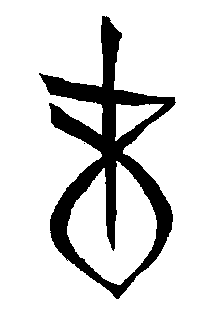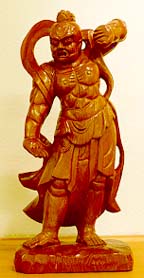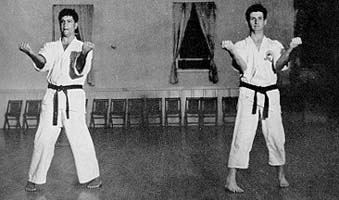


Karate Kata Training by Steve Denoo
The harder sweat when you practice your kata, the less you will bleed in combat.



Although it is important to study and train for skill in techniques, for the man who wishes to truly accomplish the way of budo, it is important to make his whole life n training and therefore not aiming for skill and strength alone, but also for spiritual attainment."New Jersey Kyokushin CNY Karate,Syracuse, NY Kyokushin,Japan Kyokushin,Endicott,NY Kyokushin world news Back to My Karate home page
|
Foot Patterns for some Katas.
|
Kata (Formal Exercises)Kata means, literally shape or form. Today there are more than 50 kata in use and practice, with schools developing their own. It is better to learn one kata very well than 50 poorly. A kata is a sequence of blocks, kicks or punches employed from one or more stances, and involves movement forward backward and to the sides.Katas are usually given names to help us remember them. Why we have kata is to heach movement from one stance and technique to another. It is also a great form of aerobic exercise that also strengthens all the muscles of the body. A further benefit is that it challenges the mind to remember the pattern and proper movements, as well as speed and application. It was a test of a students skill and advancement. As a student practiced on his own, his teacher would notice the improvement at the next class, and eventually consider the student for advancement. Mas Oyama once said that one should "think of karate as a language � the kihon (basics) can be thought of as the letters of the alphabet, the kata (forms) will be the equivalent of words and sentences, and the kumite (fighting) will be analogous to conversations." He believed that it was better to master just one kata than to only half-learn many. It has been said that theory alone will not enable you to gain and keep skill in Karate. Devotion and daily practice are the keys. You must want it. Karate training today is a progressive well thought, out and scientific in its methods. It allows you to develop slowly and completely. Miyagi is important to us in that he was the first to analyze this and developed the progressive curriculum, with a proper sequence of training. It is through his effort and contribution that turned fighting arts from secret teachings to what it is today. The new student is taught to lay a firm foundation for his eventual mastry of the Martial Arts. He is taught how to hold his body, proper breathing, how to use leverage, how to defend himself, and others. A strong foundation must be laid and only through constant practice and repetition of the basic techniques is this possible. This is done through Kata training. It is easy for students to want to learn everything now! It is far better to be a good White Belt than a poor Black belt. Patience is the key. Again Sensei Labatte says 10 years of experience, is one year of training repeated 10 times, if you have not grown or learned, you are still a beginner only older.
 
There are lots of kata to learn, each has its purpose. you should know your kata very well. Practice them until the moves are reaction instead of thought.
Classification of Katas1. FUKYU kATAS These are beginners forms. These are traditional kata and consist of Gekisai, Fukyu which are variations of Gekisai. These were developed by Master Miagi, Yagi, and Toguchi. There are 7 in this group. 2. Kihon Kata 
This is the basic development kata, developing a strong body. The primary basic kata is Sanchin followed by Pinan series. These teach movement from one technique to another, and are therefore very important. Furthermore they teach tension and relaxing, speed and flexability 3. Kishu Kata These are Open Hand katas. After World War II the open handed Chinese kata were changed to closed fist kata, and moves were modified to hide the dangerous techniques. Only after a student had proven himself would the correct teachings be given. The open hand kata actually allows a greater production of Chi to flow into the opponent. With the closed fist the chi returns to the user. The example is to take a garden hose, When the water is flowing much work can be done. When the end is blocked nothing is accomplished. the kate if this group are Saifa, Seienchin, Sanseiru, Seipai, Shisochin, Seisan, Kururunfa, and Supairenpei. 4. Heishu Kata Heishu means closed hand, or end of the forms, Tensho is the primary kata. The Northern Kata include:
The Southern Kata were developed from the study of the Okinawan karate style of Goju Ryu, which in turn were derived from southern Chinese kempo. The movements in these kata are more circular and somewhat flamboyant than those in the Northern Kata. The Southern Kata include:

Taikyokuis literally translated as "grand ultimate view" "to see clearly", and in Chinese, the kanji characters are pronounced Tai Chi. The word Taikyoku can also mean overview or the whole point � seeing the whole rather than focusing on the individual parts, and keeping an open mind or beginner's mind. The beginner's mind is what is strived for during training and in life. The beginner's mind does not hold prejudice and does not cling to a narrow view. The beginner's mind is open to endless possibilities. It is always important to remember what it was like to be a beginner. This kata is not restricted by space, and the student should remember to cover a wide area. Taikyoku means keeping an open mind, not restricting our focus, not clinging to a narrow view of any situation, be open to all possibilities.
Pinan seriesThere are 5 in this group, the first and second had their orders reversed to progress from the Taikyoku katas. The name is from the Okinawan pronunciation of the kanji characters for peace and relaxation or harmony (pronounced "Heian" in Japanese).Though the physical moves of kata involve techniques used for fighting, and it should be considered for that purpose, it is the development of moving ZEN of kata is to develop a calm, peaceful mind and harmony between the mind and body. This is the first set of Kata in which training is begun with basic and essential techniques. These Kata can be used in actual sparring. Rythm is important here. The kata are fairly short so easy to remember, but incorporate a wealth of techniques. It is believed they were taken from a much longer kata, and broken down. 
Sanchinliterally means "three battles" or "three conflicts". This Kata employs dynamic tension throughout. The advantage is that it builds a very strong body, because you are tensing all your muscles and then using them against each other. This Kata is noted for its ability to increase the body's ability to withstand blows from strong opponents. The disadvantage of this kata is that constant practice leads to a thickened heart muscle because of all the stress the heart has to go through to fight against the tense muscles. This can shorten your life in the long run.This kata is a favorite of many styles. This used to be the main kata in several styles before more were developed. It was practiced for its body strengthening properties. It can be performed alone indoors. Because of the ban on Martial Arts study by the Japanese after invading Okinawa, it became the favorite underground kata. This kata should be performed very hard. Over emphasize the hard here. It is the principal kata in most Okinawan karate styles, such as Goju Ryu and Uechi Ryu, and it is likely one of the oldest kata. Much has been written about it, so I need not go too far into it. This kata builds strong muscles, bones and lungs. If you are winded in combat you need more Sanchin kata. Certain legends attribute the creation of Sanchin to Bodhidharma in the early sixth century, which would put it as coming from the Shao Lin temple. Sanchin was developed for the attainment of physical strength.
Gekisai-dai, Gekisai-shoDai means large and Sho means small. The labeling of katas is an alternative to using numbers. Therefore these mean to conquer and occupy or destroy. The name is derived from the characters Geki, meaning attack or conquer, and Sai, meaning fortress or stronghold (literally translated as "closed", "shut" or "covered"). The word Gekisai can also mean demolish, destroy or pulverize. The katas teach strength through fluidity of motion, mobility and the utilization of various techniques. Flexibility of attack and response will always be superior to rigid and inflexible strength.The techniques are from Shuri-Te, a style admired by Master Miyagi admired, however he added the closed handed techniques to this kata therefore changing its emphasis to one of gentleness rather than deadliness. This is good practice for close in fighting. This kata teaches strength through motion and utilizes a combination of mobility and fluidness in movement. Flexibility of attack and counter attack that will be superior and lead to the opponents defeat. Rigid and inflexible bruit strength will not prevail. These are practiced with an emphasis on smoothness of the moves, with a combination of slow and fast movements.
YansuThis is one of my favorite kata and is derived from the characters Yan, meaning safe, and Su, meaning three. The name is attributed to that of a Chinese military representative to Okinawa in the 19th Century. The word yansu also means to keep pure, striving to maintain the purity of principles and ideals rather than compromising for expediency. I always liked this kata a lot. It is short but there is something about it that appealed to me.Yantsu has a fairly vague history although it is believed by some to have had origins in Naha, Okinawa. Yantsu can mean "8th Light" and like so many Naha forms has numbers in its name. Three form begins with a cross grabbing motion often referred to as a "Goju Break". As is often the method of naming things in oriental languages, the kata name is a description of the action taken rather than of the word itself as is the case in western languages. The kata employs unique footwork, feints and parries and even some crane movements. It is used also in Motobu Ha Shito Ryu where they call it Ansan. In Shito Ryu it is a bit longer than that of used in Kyokushin; the story is that Kuniba probably taught the Kata to Oyama, who then shortened it to the version taught within Kyokushin. Sometimes translated as "To maintain purity", striving to maintain the purity of your principles and ideals, rather than compromising for the expedient. Generally it is only found in Kyokushin derived styles and in Chinese Kempo schools where it probably originated. At any rate you are to keep yourself pure, while striving to maintain the purity of principles and ideals rather than compromising. Therefore the Safe Three: (1) Maintain Purity: Principles and ideals rather than compromising for expediency and that these ideals may never be betrayed in favor of other immediate advantages. (2) One must strive daily and create a sense of urgency to overcome weakness and (3) to forge a strong will and spirit. Creation to Mas. Oyama. One story is that it is supposedly based on a Chinese "kata" or possibly something he may have learned in Korea in his youth. Either way it is found mostly in Kyokushin and descending styles ("world Oyama karate" and "World Seido Karate" among others). In the early days he was picking up kata from students and modifying them for his own use. Since Oyama is not here to correct the errors and answer the questions, it is up to his followers to search out the truth, just as he would have wanted it. Is that not why the style is called Kyokushin?
TenshoThis Kata means rolling or fluid hand, literally translated as "rotating palms". It is also translated into turning palm, from the wrist techniques. This kata was developed by Master Miyagi and its movements are in the Pakua style. Tje breathing is softer than Sanchin kata, it is recommended that it be the last kata practiced to help calm the spirit. Tensho is the soft and circular (yin) counterpart to the hard and linear (yang) Sanchin kata. Not only was Tensho one of Mas Oyama's favorite kata, he considered it to be the most indispensable of the advanced katas.
Saihameans extreme destruction, smashing or tearing. The word Saiha can also mean great wave, the source of the IFK logo. No matter how large a problem is encountered, with patience, determination and perseverance (Osu) one can rise above and overcome it, or smash through and get beyond it.
KankuThis kata was favored by master Funakoshi, who used it to demonstrate Karate, saying that it contained all the essential elements of Karate. It means sky gazing or viewing. Literally translated, Kan means "view", and Ku means "universe", "air", "emptiness" or "void" (the same character as Kara in karate). The first move of the kata is the formation of an opening with the hands above the head, through which one gazes at the universe and rising sun. The significance is that no matter what problems are faced, each day is new and the universe is waiting. Nothing is so terrible that it affects the basic reality of existence.Another important feature is that as you look at the triangle of your hands you focus. The world at large disappears as you focus your mind, all that is trivial and unimportant are no more, and you are ready for battle. This is the mental attitude of Zanshin, which must be developed in the martial artist. This is the state of mind that enables you to win. No technique should be 'pulled' short of the target for fear of inflicting injury to the opponent.
Seienchin,Means to pull and grab in battle, to conqueror and subdue over a distance, or attack the rebellious outpost. There is an occasion when you may need to pull an opponent towards you, or to break loose from his grasp. There are no kicks in this kata.The purpose of the kata is to show that a laarge man can be defeated by changing directions quickly. Movement of feet and hands are stressed. This kata is mostly performed in Shiko-dachi, and it develops great strength in the legs and hips. It is none of the most important katas and should be done very hard. It is one of my personal favorites. In feudal Japan, Samurai warriors would often go on expeditions lasting many months, and they needed to maintain their strength and spirit over a long period of time. This kata is long and slow, with many techniques performed from kiba dachi (horseback stance). The legs usually become very tired in this kata, and a strong spirit is needed to persevere, instead of giving up. The word Seienchin can also mean to pull in battle.
Garyu,means reclining dragon. In Japanese philosophy, a great man who remains in obscurity is called a Garyu. A dragon is all-powerful, but a reclining dragon chooses not to display his power until it is needed. Likewise, a true karateka does not brag about or show off his abilities. He never forgets the true virtue of humility.
Seipaiis the Okinawan pronunciation of the kanji characters for 18. The pronounciation is "Ju Hachi" in Japanese. In other karate styles, this kata is sometimes called Seipaite, or eighteen hands.This kata came from the 18 Loan techniques from the Southern Shaolin Kenpo. This kata has 18 techniques with special features, the kata changes its form several times. This kata is from the Southern Shaolin Kenpo. The number 18 is derived from the Buddhist concept of 6 x 3, where six represents color, voice, taste, smell, touch and justice and three represents good, bad and peace. Special Feaatures of the Kata are:
|